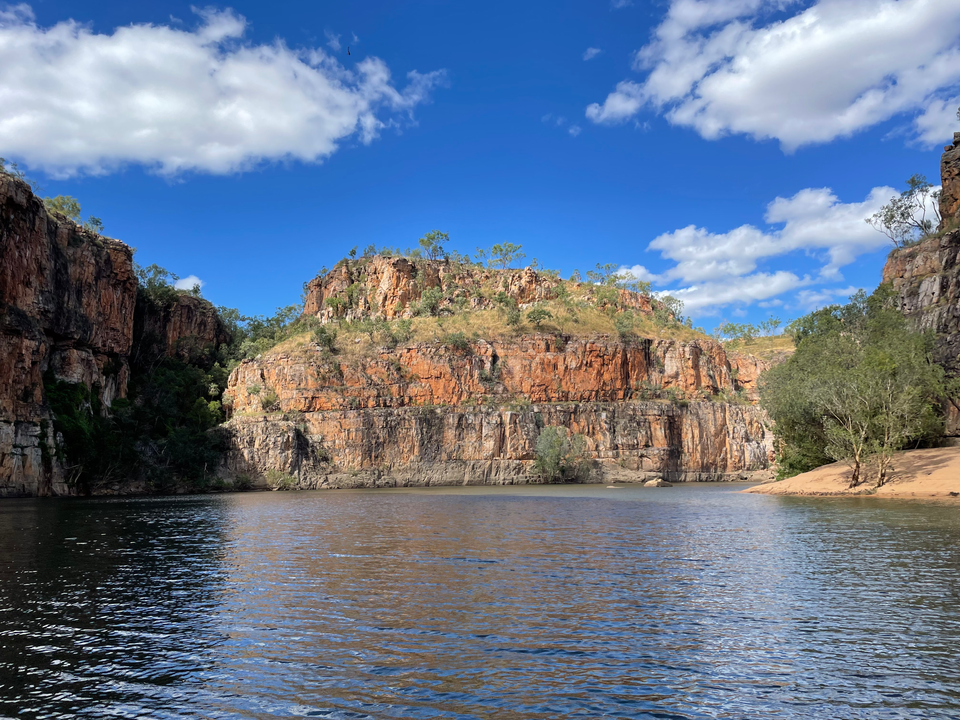Use Your Local Knowledge To Build Your Writing Portfolio

My husband and I (and all the other people on the boat tour) craned our necks to spot what, an hour before, I’d sworn up and down I didn’t want to see.
We were looking for freshwater crocodiles on the Katherine river in Nitmiluk National Park. And our tour guide and boat captain, Russell, had just spotted one, the second of three that we would see that day.
To be honest, I’m not that keen on crocodiles of any sort.
I don’t even really like stuff made out of their skin. There’s just something so … reptilian about it.
But what I learned from our guide, Russell, made them seem like fascinating creatures.
For example, it’s safe to go swimming with them.
Yup. That’s what Russell said.
Because their snouts are too small to chow down a human. So they tend to eat bats and birds and smaller creatures.

The only time, Russell said, that a freshwater crocodile will bother you, is if you go bother it.
You know. Stupid stuff like poking it with a stick to make it smile, while you’re trying to get a selfie with it.
Now saltwater crocodiles ….
Well, saltwater crocodiles are another thing altogether. They are much bigger and, as Russell quite dryly put it, they WILL eat you.
So if any saltwater crocs are spotted in any place where humans like to swim, the shut down the swimming holes and put closed signs up everywhere.
Hence there was no one swimming in the river that day because there had been a saltwater croc sighting the week before.
And no canoeists either. Apparently canoes are a sign that there’s a tasty snack aboard.
One little bump from a saltwater croc and you’re out of the canoe and into the water. A bit like shelling peas.

I was really glad we had Russell as our guide on that boat tour. He was a local man and really knew his stuff, mixing it in with dry wit that makes you think while you’re laughing.
And it’s the same when you’re writing about something you know really well. You can still have all the facts, but you can talk about them in a way that makes them entertaining and engaging.
Which means that people will remember your words longer. And pay more attention to them.
Because just maybe YOU could be the local telling all the visitors where it's safe to go swimming and where all the saltwater crocs are.

So I have a question for you.
If you're thinking of getting into travel writing ... either as a way to start getting paid or as so you can add another niche to your portfolio ... is there something you know about the place you live that visitors don't?
Something they would love to know? Or maybe even need to know in order to stay safe?
No one wants to be swimming with the saltwater crocs. So if you can tell people what to watch out for when they are in your local area, they WILL appreciate it.
And write about your local area enough times and you'll start to be seen as something of an authority. Plus you'll be building up your portfolio of work, which will come in handy when you begin pitching editors with story ideas.
But what if you're just getting started as a freelance writer?
And you DON'T have any portfolio to show editors at all!
This was a question I had for Lindy Alexander, who is an award winning travel writer (you can check out her travel writing course here). I recently interviewed her for my Online Business Launchpad podcast (keep an eye out for when the episode drops).
And Lindy told me that one of the best ways to get your foot in the door (if you don't have a portfolio yet), is to write about a personal experience you've had.
She did emphasise that you'll need to have a specific angle to pitch to the editor of the magazine you hope will take your story.
You can't just write about "what I did over the summer". Unless, of course, what you did over the summer has given you something to say that needs to be said.
What if the editor still wants writing samples?
One other little tip Lindy shared was that if the editor does come back and ask you for writing samples or examples, you can explain that you're just getting started and offer to write the article "on spec".
Lindy did add, that while she doesn't normally advocate for writing for "free", in this particular instance it can be worth it. Because the editor will either say yes and you'll get your first paid piece. Or you'll get a no, but you've now got the start of a portfolio.
All it has cost you is a bit of time (and maybe some ego, but as a writer, rejection is part and parcel of the pitching process).
It's not a reflection on you as a person or writer. It just wasn't the right time for that idea to shine.
Time to take action
So my challenge for you is to make some space in your full calendar. Then do the following:
- Go find a quiet space and start brainstorming ideas for your article.
- See if you can come up with a personal experience you've had with something from your local area. It could be an indoor or outdoor space you love (or hate). It might a local business where the people are particularly friendly or welcoming (or the exact opposite). It might be an event you've been to recently that's had a deep impact on you.
- Write down what it was about your experience in your local area that others need to know so that they can either have the same type of experience? Or know what to be wary of and why (remember those saltwater crocs).
- Create a short email pitching your idea for it.
- Send your pitch!
Not sure who to send your pitch to?
Try your local council or your city/county communications team. They are always looking for content for their newsletters.
Try your local newspaper (if one still exists in your area) or local tourism organisations.
And do some research to see what organisations or businesses in your local area post on their websites. They might be interested in what you have to say as well.
And when you get someone to say yes to. your article, let us know. We'll be delighted to celebrate your win with you.
Please note that as an Amazon Associate, we earn from qualifying purchases. That means that if you click on one of our affiliate links (these are clearly identified) then we will receive a small commission, for which we thank you. It helps us keep on providing informative posts that help you build your freelance writing career and business.


Member discussion